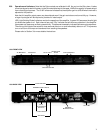17
then the fault is somewhere in the bad channel. Check the input program switches, octal accessory (if any) or jacks.
See Section 3.5 for correct switch settings. Inspect the binding posts for damage, and try a different input jack
or the parallel channel switches before giving up on the channel.
3.93 Weak But Clear Sound This usually indicates lack of input signal or incorrect Gain adjustment at some point.
Again, if the other channel is working, try swapping connections to see if the problem is in the channel or elsewhere.
If the sound is very thin or muffled, one driver in a multiple-way speaker may have failed.
3.94 Weak and Distorted Sound If the amplifier clip light comes on during the distortion, there is a shorted speaker
cable, the speaker is blown, or the amplifier channel is defective. If the clip light does not show during the distortion,
this shows that the distortion is happening outside of the amplifier. You will have to check for misadjusted or
defective units before the amplifier, or defective speakers. Also verify that amplifier Gain is in the normal range
(half-way up or higher).
3.95 Sound Cuts In and Out This is usually caused by a bad connection. See if shaking the amp or the input/output
connectors causes the problem. If the sound cuts out for a minute and then comes back on by itself, check the
amplifier for overheating (thermal cut-out). An intermittent connection to one side of the balanced input can cause
a 6 dB fluctuation of input level.
3.96 Sound Has Bad Tone (poor treble or bass) The amplifier itself is very unlikely to develop a frequency response
problem, without more serious effects. Therefore, lack of frequency range must be traced to the speakers or
preceding units.
3.97 Lacks Power This is a common but indefinite complaint. Is there a lack of power in the sense that it is soft but
clear (see Section 3.93) or does it seem to distort too easily (see Section 3.94). Also, be aware that speaker
efficiency will drop perceptibly after heavy usage, due to the increased resistance of the voice coils as they heat
up; volume will return when the speakers cool down.
In a multi-speaker system, be sure all of the speakers are still working. Finally, of course, your ears get used to
high sound levels, and as the room fills up with people, the sound will be absorbed more greatly. Only a sound
level meter, used with a standard signal level and at a standard distance from the speaker, can really tell if you
are getting the expected output.
3.98 UNWANTED NOISES
Hum—in this case, defined as a fairly rounded 60-cycle tone. Severe hum usually is caused by broken cables
or jacks, with a disconnected ground (shield). This problem can also be caused by corroded connectors, espe-
cially 1/4-inch types. For this reason, high-reliability systems should use the XLR or barrier-strip inputs.
A milder form of hum, often with a little more “tone” or harmonic content, is usually the result of ground loops. This
problem is caused by 60-cycle magnetic fields, which radiate from power transformers, including the ones in the
amplifier. Try re-positioning the cables away from the various components. Note that tape recorder heads, phono
cartridges, and electric guitar pick-ups are especially sensitive to this type of interference, and must be kept away
from high power electronics.
Buzz—defined as a very “razzy” kind of hum. This is usually caused by interference from solid-state light-dimmer
circuits. Follow the same precautions shown above, and make sure the electronics are not connected to an AC
outlet which has a dimmer control.
Hiss—defined as a smooth “shhh” noise. This is always a problem with sensitive, high-gain electronic inputs, and
usually starts at the point of weakest signal. First, check the power amp by unplugging the input cables. Any
residual noise (hiss and hum) should be barely audible even with your ear right up to the speaker. Assuming that
the amp is OK, you will have to trace the hiss to an earlier part of the system. In a properly designed system, this
will be the initial microphone, phono, or tape source.
There is a noise “floor” caused by random atomic vibrations. This limits the signal-to-noise ratio of the original
signal; the goal of a proper system is to immediately amplify that signal well above the noise floor so that further
degradation does not occur. “Gain-staging” is a subject in itself, but the principle is to maintain a reasonably
constant signal level after leaving the initial pre-amp. The signal must be kept below the point of distortion, and
well above the noise floor.
To isolate the source of unwanted hiss, start at the amp, and work backwards, reducing and then restoring gains.
You should hear a reduction of hiss and audio together at each point, showing that the hiss is coming in earlier.
When you find a control which lowers the audio volume, but not the hiss level, you know the hiss is coming in after


















